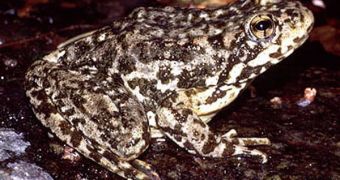Naturalists have managed to finally rediscover a species of extremely rare and endangered mountain yellow-legged frogs, which were last spotted some half a century ago in California. Scientists from the United States Geological Survey (USGS) and the San Diego Natural History Museum discovered the elusive amphibians in the San Bernardino National Forest, after following the same course as a San Jacinto Wilderness expedition, conducted in 1908. LiveScience reports that biologists are optimistic that the find will aid them in their efforts to conserve this rare species.
At the global level, the challenges facing frogs, and amphibians in general, are very diverse and difficult to overcome. Countless species lose their habitat quickly, either on account of human intervention, or because global warming modifies the established ecosystems. Despite the fact that these animals can adapt very quickly, even their fast evolutionary pace cannot keep up with the changes that happen in their environments from year to year. Additionally, they are also threatened by the dangerous chytrid fungus, a pathogen that decimates entire frog populations.
On the bright side of things, with the new discovery, the Californian mountain yellow-legged frogs could have a shot at survival. Captive breeding programs, coupled with frog habitat-preservation programs, could aid in the recovery of this species. Two distinct populations were found near the Tahquitz and the Willow creeks, about 2.5 miles apart. Biologists failed to provide an accurate count of just how many individuals were in each population, or if the two groups were related to each other.
“If this population is large, it could play an important role in the re-establishment of this species across Southern California,” USGS scientist Adam Backlin, who has been the leader of the survey team that traveled near the Tahquitz Creek, explains. The group found the first frogs of this species on June 10th. The finds are of paramount importance for the future of this species because, until the expeditions, it was estimated that only about 122 adult frogs of this type lived in the wild.

 14 DAY TRIAL //
14 DAY TRIAL //